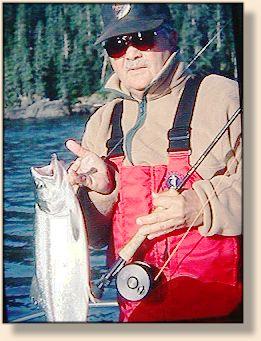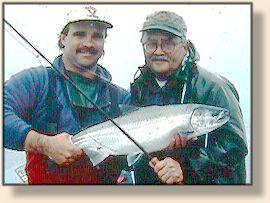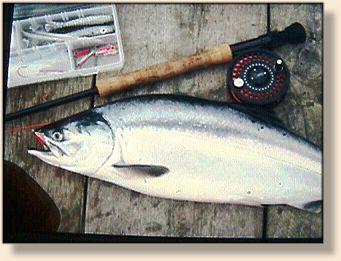Saltwater Fly Rodders: Think Pink!
By Les Johnson
 QUEEN CHARLOTTE ISLANDS, British Columbia -- My long-time
fishing partner, Bruce Ferguson cut the motor to let our 17-foot Boston
Whaler drift slowly toward a long kelp raft that was floating between
Coneehaw Rock and Gunia Point. I was on the bow platform with fifty
feet of intermediate sinking line coiled on the deck. My fly was a hot pink
euphausid pattern dressed on a long-shanked, size 6 hook. As the boat
drifted into range I could clearly see the school of pink salmon nosing
around in the kelp, feeding on euphausids. I made one hard back cast and
set the fly out along the edge of the kelp. Before the hot pink offering had
sunk two feet, the line snapped tight and I was fast to a husky and spirited
pink salmon.
QUEEN CHARLOTTE ISLANDS, British Columbia -- My long-time
fishing partner, Bruce Ferguson cut the motor to let our 17-foot Boston
Whaler drift slowly toward a long kelp raft that was floating between
Coneehaw Rock and Gunia Point. I was on the bow platform with fifty
feet of intermediate sinking line coiled on the deck. My fly was a hot pink
euphausid pattern dressed on a long-shanked, size 6 hook. As the boat
drifted into range I could clearly see the school of pink salmon nosing
around in the kelp, feeding on euphausids. I made one hard back cast and
set the fly out along the edge of the kelp. Before the hot pink offering had
sunk two feet, the line snapped tight and I was fast to a husky and spirited
pink salmon.
Bruce and I have enjoyed several seasons fishing the water around the
incomparable Queen Charlotte Islands. Working the rips and tide changes
around tiny Langara Island; from Coho Point to Langara Rocks; Parry
Passage to Pillar Rock Bruce and I have taken a great many coho, chum
and pink salmon on the fly. Bruce has even taken a scattering of elusive
sockeye and I have landed a few springs over the years. It is particularly
satisfying because these are bright, feeding salmon taken on cast flies -- in
the salt. Although the highly esteemed spring salmon is the big boy, coho
the aerial champ, chum the most tenacious and sockeye the enigma, it is
the lightly regarded pink that can truly make the day memorable for the
angler who prefers to fish with a fly rod.
 Pink salmon abound in the food-rich waters around Langara Island from
late June through early September. They run in schools in the upper ten
feet of the water column, particularly when they are feeding on euphausids,
one of their preferred foods. The euphausid is a shrimp-like critter,
approximately an inch in length, that sometimes appears in large swarms
near the surface, generating incredible pink salmon feeding sprees (be
advised that coho, chum, sockeye and even springs also partake of these
little tidbits with gusto on occasion). When pinks are feeding in the surface
film, fishing for them with a fly rod becomes a stalking and hunting game.
Drifting quietly into range and casting to a feeding pink salmon can require
all the stealth and deft presentation that you would equate with hooking a
choosy old bank-feeding brown trout, or super-selective spring creek
rainbow.
Pink salmon abound in the food-rich waters around Langara Island from
late June through early September. They run in schools in the upper ten
feet of the water column, particularly when they are feeding on euphausids,
one of their preferred foods. The euphausid is a shrimp-like critter,
approximately an inch in length, that sometimes appears in large swarms
near the surface, generating incredible pink salmon feeding sprees (be
advised that coho, chum, sockeye and even springs also partake of these
little tidbits with gusto on occasion). When pinks are feeding in the surface
film, fishing for them with a fly rod becomes a stalking and hunting game.
Drifting quietly into range and casting to a feeding pink salmon can require
all the stealth and deft presentation that you would equate with hooking a
choosy old bank-feeding brown trout, or super-selective spring creek
rainbow.
When you feel the wrist-wrenching grab of a mature pink salmon however,
you realize immediately that you aren't connected to a trout. The pink salmon
around Langara Island weigh in at 5 to 8 pounds, with a few tipping the
scales at more than 10 pounds -- and they are absolute bundles of strength,
speed and stamina that will give you a real workout. By about 10 a.m.,
successfully hunting, hooking and landing a half-dozen, or more pink salmon
on the fly will have you checking your watch to see if it is time for a lunch
break at the lodge.
If you have fished along the West Coast of British Columbia or the United
States for pink salmon that are entering natal rivers, you are going to be in
for a surprise when you set eyes on your first Queen Charlotte Islands pink.
Even early arriving pinks in a river display the first signs of spawning; a graying
of the flanks, a bit of a shoulder hump and an emerging kype on its jaw. In
sharp contrast, the pinks you'll encounter at Langara Island are sleek-bodied
with a faint, iridescent, lavender highlight painted lightly over their chrome silver
sides and gill covers. In a word, the pink salmon around Langara Island are
prime. They are in prime condition, prime for the fly rod and prime on the table.
It is important to note that pink salmon are opportunistic, not selective, feeders.
If euphausids are in short supply, aggressively feeding pink salmon will join up
with springs, coho and chum to forage eagerly on anchovies, sand lance
(needlefish) and small herring. So you need to have a selection of proper
baitfish patterns in your fly box in addition to euphausids.

When fly fishing for feeding pink salmon with a euphausid or baitfish pattern,
it is critical to get your cast out quickly with a minimum of back casting.
Waving a fly line too many times over a school of pinks nosing around in
the surface film can put them down. A weight-forward line that loads your
rod quickly and turns the fly over at sixty feet is the ticket. You want your
fly to land lightly, even on those magic days when nothing seems to put the
pinks down. When you see pinks jumping, it usually means that the school
is on the move. Pick out a pink salmon within casting range and figure out
the direction it is moving. Place your cast ahead and slightly beyond its path.
Allow the fly to sink for a three-count and begin a series of six-inch strips,
keeping the rod tip low. It usually doesn't take long to be rewarded with
a hookup.
The right fly rod for fishing here is a 9-foot, 8-weight with matching
weight-forward floating, intermediate sinking and
type IV sinking lines. Leave the sink-tip lines at home.
Your leaders should be 7 1/2 to 10 feet and taper to about a 10-pound
test tippet. Your reel should have an adjustable drag, a corrosion-resistant
finish for use in saltwater and capacity enough for the fly line and 150 yards
of 18- to-20-pound- test braided backing. This outfit also works perfectly
for coho, chum and sockeye. If you are considering a go at spring salmon,
bring a 10-weight outfit with the same selection of lines, a reel that will hold
200 yards of 30-pound-test backing and leaders tapering to 15- pound-test
(minimum). Bring your own flies. Tight lines! ~ Les Johnson
About Les:
 Les Johnson has fished for salmon in the Pacific Ocean
with a fly rod for more than thirty years. His experience covers the
coastal waters of California, Oregon, Washington, British Columbia
and Alaska. During a writing career that spans four decades Les has
written more than 200 published articles and three books based on
fishing experiences from Alaska to Mexico and Washington to
Massachusetts. He is author of Fishing the Sea-Run Cutthroat
(Seven printings since 1972); co-author of the book Fly Fishing for
Pacific Salmon, (Bruce M. Ferguson, Les Johnson, Patrick Trotter),
1985 and co-author of Tube Flies (Mark Mandell, Les
Johnson, 1995). Les was founding editor of Fly Tying magazine.
Les lives in Seattle, Washington with his wife, Carol. You may contact Les
for information on his fishing presentations and clinics at
lesj@seanet.com.
Les Johnson has fished for salmon in the Pacific Ocean
with a fly rod for more than thirty years. His experience covers the
coastal waters of California, Oregon, Washington, British Columbia
and Alaska. During a writing career that spans four decades Les has
written more than 200 published articles and three books based on
fishing experiences from Alaska to Mexico and Washington to
Massachusetts. He is author of Fishing the Sea-Run Cutthroat
(Seven printings since 1972); co-author of the book Fly Fishing for
Pacific Salmon, (Bruce M. Ferguson, Les Johnson, Patrick Trotter),
1985 and co-author of Tube Flies (Mark Mandell, Les
Johnson, 1995). Les was founding editor of Fly Tying magazine.
Les lives in Seattle, Washington with his wife, Carol. You may contact Les
for information on his fishing presentations and clinics at
lesj@seanet.com.
Our Man In Canada Archives
|

 QUEEN CHARLOTTE ISLANDS, British Columbia -- My long-time
fishing partner, Bruce Ferguson cut the motor to let our 17-foot Boston
Whaler drift slowly toward a long kelp raft that was floating between
Coneehaw Rock and Gunia Point. I was on the bow platform with fifty
feet of intermediate sinking line coiled on the deck. My fly was a hot pink
euphausid pattern dressed on a long-shanked, size 6 hook. As the boat
drifted into range I could clearly see the school of pink salmon nosing
around in the kelp, feeding on euphausids. I made one hard back cast and
set the fly out along the edge of the kelp. Before the hot pink offering had
sunk two feet, the line snapped tight and I was fast to a husky and spirited
pink salmon.
QUEEN CHARLOTTE ISLANDS, British Columbia -- My long-time
fishing partner, Bruce Ferguson cut the motor to let our 17-foot Boston
Whaler drift slowly toward a long kelp raft that was floating between
Coneehaw Rock and Gunia Point. I was on the bow platform with fifty
feet of intermediate sinking line coiled on the deck. My fly was a hot pink
euphausid pattern dressed on a long-shanked, size 6 hook. As the boat
drifted into range I could clearly see the school of pink salmon nosing
around in the kelp, feeding on euphausids. I made one hard back cast and
set the fly out along the edge of the kelp. Before the hot pink offering had
sunk two feet, the line snapped tight and I was fast to a husky and spirited
pink salmon.
 Les Johnson has fished for salmon in the Pacific Ocean
with a fly rod for more than thirty years. His experience covers the
coastal waters of California, Oregon, Washington, British Columbia
and Alaska. During a writing career that spans four decades Les has
written more than 200 published articles and three books based on
fishing experiences from Alaska to Mexico and Washington to
Massachusetts. He is author of Fishing the Sea-Run Cutthroat
(Seven printings since 1972); co-author of the book Fly Fishing for
Pacific Salmon, (Bruce M. Ferguson, Les Johnson, Patrick Trotter),
1985 and co-author of Tube Flies (Mark Mandell, Les
Johnson, 1995). Les was founding editor of Fly Tying magazine.
Les lives in Seattle, Washington with his wife, Carol. You may contact Les
for information on his fishing presentations and clinics at
lesj@seanet.com.
Les Johnson has fished for salmon in the Pacific Ocean
with a fly rod for more than thirty years. His experience covers the
coastal waters of California, Oregon, Washington, British Columbia
and Alaska. During a writing career that spans four decades Les has
written more than 200 published articles and three books based on
fishing experiences from Alaska to Mexico and Washington to
Massachusetts. He is author of Fishing the Sea-Run Cutthroat
(Seven printings since 1972); co-author of the book Fly Fishing for
Pacific Salmon, (Bruce M. Ferguson, Les Johnson, Patrick Trotter),
1985 and co-author of Tube Flies (Mark Mandell, Les
Johnson, 1995). Les was founding editor of Fly Tying magazine.
Les lives in Seattle, Washington with his wife, Carol. You may contact Les
for information on his fishing presentations and clinics at
lesj@seanet.com.
 Pink salmon abound in the food-rich waters around Langara Island from
late June through early September. They run in schools in the upper ten
feet of the water column, particularly when they are feeding on euphausids,
one of their preferred foods. The euphausid is a shrimp-like critter,
approximately an inch in length, that sometimes appears in large swarms
near the surface, generating incredible pink salmon feeding sprees (be
advised that coho, chum, sockeye and even springs also partake of these
little tidbits with gusto on occasion). When pinks are feeding in the surface
film, fishing for them with a fly rod becomes a stalking and hunting game.
Drifting quietly into range and casting to a feeding pink salmon can require
all the stealth and deft presentation that you would equate with hooking a
choosy old bank-feeding brown trout, or super-selective spring creek
rainbow.
Pink salmon abound in the food-rich waters around Langara Island from
late June through early September. They run in schools in the upper ten
feet of the water column, particularly when they are feeding on euphausids,
one of their preferred foods. The euphausid is a shrimp-like critter,
approximately an inch in length, that sometimes appears in large swarms
near the surface, generating incredible pink salmon feeding sprees (be
advised that coho, chum, sockeye and even springs also partake of these
little tidbits with gusto on occasion). When pinks are feeding in the surface
film, fishing for them with a fly rod becomes a stalking and hunting game.
Drifting quietly into range and casting to a feeding pink salmon can require
all the stealth and deft presentation that you would equate with hooking a
choosy old bank-feeding brown trout, or super-selective spring creek
rainbow.